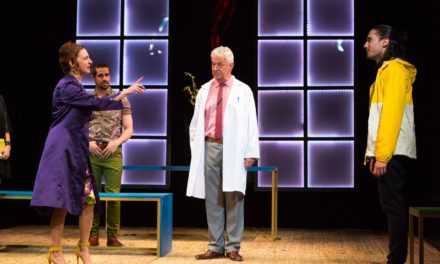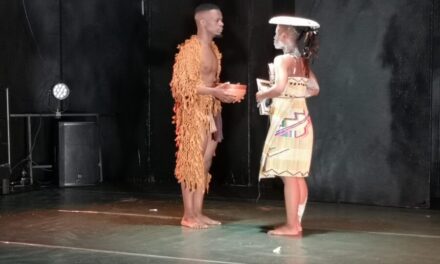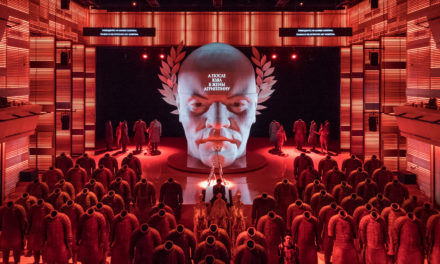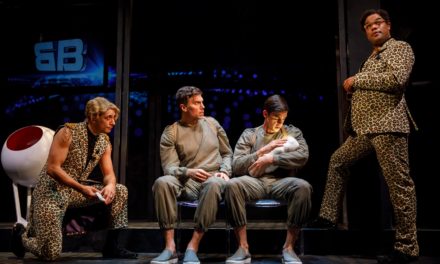Alexandra Bachzetsis’s latest group performance, 2020: Obscene, estranges the word obscene from its sexual connotation and turns it into a stage play that challenges normative gender roles.
I know it isn’t your scene
It’s better than a sex scene
And it′s so fucking obscene, obscene, yeah
In one of his early songs, Marylin Manson points towards the difference between a sex scene and something that is obscene. In Alexandra Bachzetsis’s 2020: Obscene, presented at the Tanzquartier Vienna, the stage is divided into two areas. One is clothed in a bright red, the other in a yellow plastic coating. A microphone is placed centre-stage, and on each side stands a tripod camera. Over the course of the evening the performers also act in front of the camera, with the digital video sequence being screened onto the large wall at the backend of the stage. The performance’s combined film and stage set up does not bring up the obsolete question if the performers are performing for us or for the camera; instead, it begs the question: does it matter that the audience is physically present in the same space, and at the same time, as the performers?
The show starts with the male performer Konstantinos Papanikolaou, introducing himself to us as a repeatedly hired actor in Alexandra’s work. Then Alexandra, the choreographer and leading character of the performance, appears in front of him on the stage. She personifies an elegantly moving domina, wearing a black G-string leotard with sharp black high heels, and takes over the attention by seductively coiling around a ballet bar in the front corner on the left side of the stage. Time and again she reiterates, the well-worn phrase “don’t touch me ever”, speaking into the direction of the stage where Konstantinos stands with one of the cameras.
The loose narrative between the man and woman doesn’t go very far. It circles around a couple of catch phrases and comes to an end with the third actor, Owen Ridley-DeMonick, appearing on the stage. He sits extremely closely to Papanikolaou in front of the camera, on the right red side of the stage, which shows intimately moving images of them being projected on the large wall behind them.
The male-female and same-sex couple sequences at the beginning of the performance are further complexified with the appearance of the fourth actor Tamar Kisch. She dances a physically captivating and energetic solo. Her sharp use of hands, knees, and arms generates powerful gestures and nuanced movement qualities that are reminiscent of the minimalistic and piercing body language developed by Anne Teresa De Keersmaeker for Rosas danst Rosas in the mid-1980s.
Later, when the next scene focuses on the two male actors, Tamar mirrors Alexandra’s choreographic steps. The connection between the middle-aged and younger women, in contrast to the sexualised couple constellations, grows stronger with each scene. And after Owen’s performance of Alphaville’s sentimental classic pop song Forever Young (the other actors also perform renown songs later), the atmosphere in the space is so emotionally charged that there is no interpretational doubt: the two women do not just perform together, but they idealistically support each other throughout the choreography, and thereby cut across generational stereotypes. Unlike well-intended attempts to rebalance structurally installed gender inequalities in real life, there is no artificial gender mainstreaming going on here. Instead, the roles of both sexes are complexified by the social relations that they perform in different scenes.
It is striking that even the performance’s most intimate moments that mimic sex scenes appear deprived of bodily passion. No untamed interactions are being staged across and between men and women. Full body control keeps the emotional worlds of the performers at a distance. The unconcerned negative attitude with which the performers interact is however dramaturgically effective: It subtly puts normalised conceptions of love relationships and coupledom at stake.
Not even the threesome bed scene contains instances of unbridled emotional indulgence. Desire, lust, and appetite are visibly absent. When Konstantinos lies belly down on a mattress that is covered by a black-and-white fur in the centre of the stage, with Timar placed on top of him, Alexandra takes a seat on their joint buttocks with her naked butt. Here no sexual energy is acted out. No physical or emotional border is being crossed. Every single move Alexandra demonstrates appears choreographed right down to the minutest detail. She thereby creates a strong image that one can look at to intellectually question relationships across socially-encoded gender roles.
The question of how identities are represented looms through the whole performance. Pace the implicit gender issues, the performed relations across and between the sexes fuel, and at the same time sublate, differences between performing for a camera or for a live audience. Similar to its formal performance framework, Alexandra’s group performance is neither just about the individual performers, nor does it mould specific archetypical personas that they represent. Instead it brings to the fore the complexity implicit in social relationships that hold the show together. Not the performers are presented as authentically moving allegories, but their emotions are staged as embodied allegories in front, as well as behind the camera.
Within our oversexualized and obsessively mediated culture, it seems logical that no real sexual content is featured in Alexandra’s choreography. As breaking taboos has been normalised since the late twentieth-century alongside the porn business going viral in the 2000s, which gives the option to consume porn at home, the artificial randiness implied in the staging of sexual intercourse on the stage has, as recently demonstrated by Paul McCarthy’s live performed and at the same time videotaped NV/Night Vater/Vienna at the Volkstheater in Vienna, been done to death. In the sexless choreography of 2020: Obscene the filmic stage design technically adds a further reality layer to its gender-focus and thereby challenges the normative relation between the audience’s gaze and the camera eye more subtly.
Notably, the number 2020 in the title of the performance refers back to the year in which the pandemic made rehearsing, not to speak of performing, almost impossible. As Alexandra told us, her audience, in the artist talk straight after her show, she pressed forward with organizing live rehearsals in these culturally and socially challenging times. The timely postponement of publicly presenting Obscene matches its aesthetic quality. Entangled in social relations, no one falls out of line, individual identities lose their meaning, and insinuated sex scenes demonstrate the hunger for emotional connection.
With Alexandra Bachzetsis’s group performance being explicitly sexless and unseductive, she investigates the relations and emotions underpinning sexual intercourse on the stage. The relationality that the show mediates in a negative, abstract, and yet bodily form reminds me of Lauren Berlant and Lee Edelman’s approach to sex. In Sex or the Unbearable, they dialogically conceive of the relationality implied in sex as a site to investigate our hopes, fantasies, expectations, desires, and anxieties. If the performance’s analysis of sexuality is a helpful focal point to grasp the complex subtext of social relations, without aiming to provoke affective reactions, then let’s remember the rhythm of Marilyn Manson’s chorus of mOBSCENE: “Be obscene. Be, be obscene. Be obscene, baby.”
*As of January 2023, Marilyn Manson was sued for sexual assault of a minor. Several sexual harassment cases have been brought against him in the past. For an overview see: https://eu.usatoday.com/story/entertainment/celebrities/2023/01/31/marilyn-manson-lawsuits-sex-abuse-allegations-timeline/11153419002/
This post was written by the author in their personal capacity.The opinions expressed in this article are the author’s own and do not reflect the view of The Theatre Times, their staff or collaborators.
This post was written by Lisa Moravec.
The views expressed here belong to the author and do not necessarily reflect our views and opinions.


















